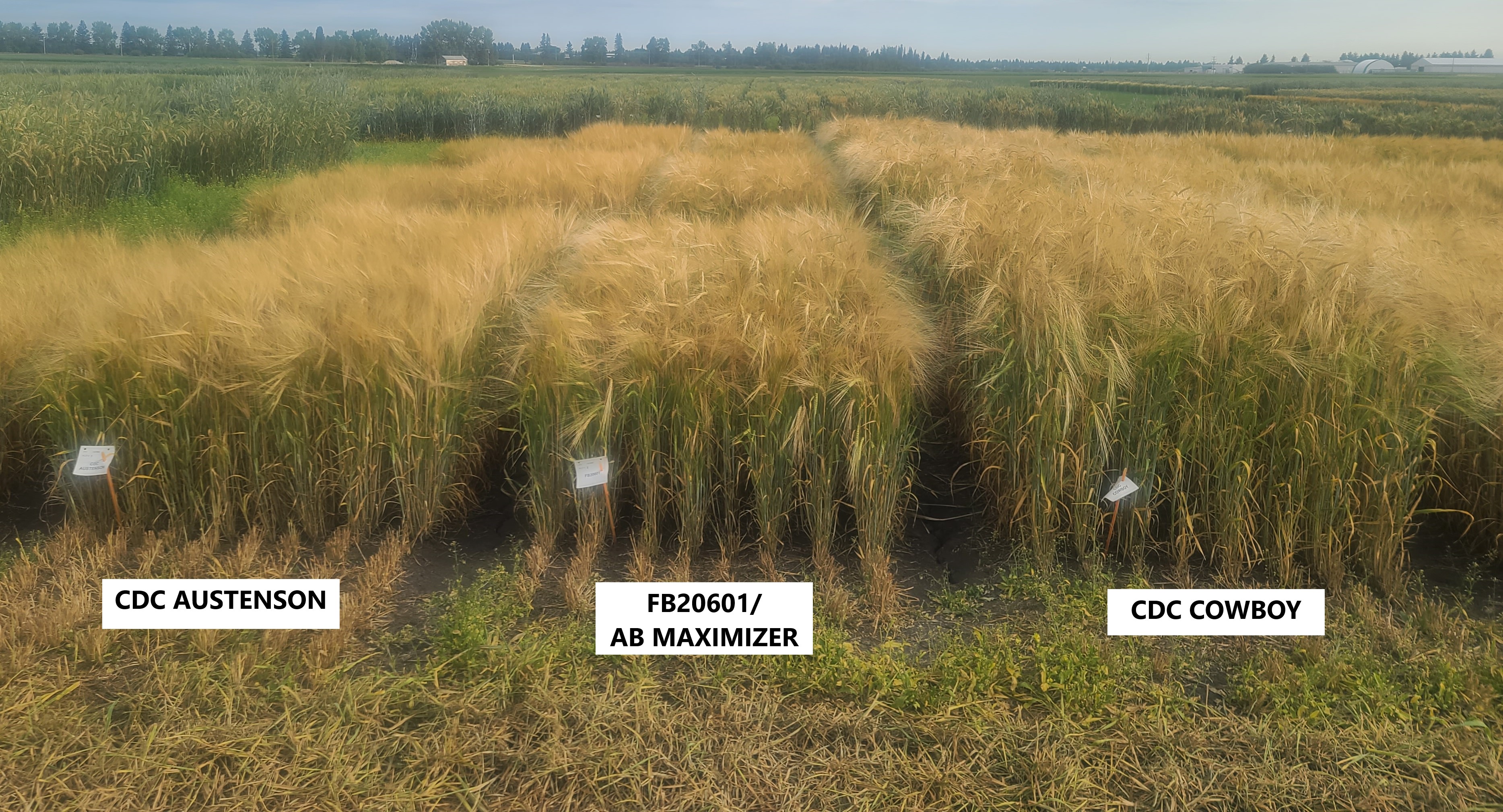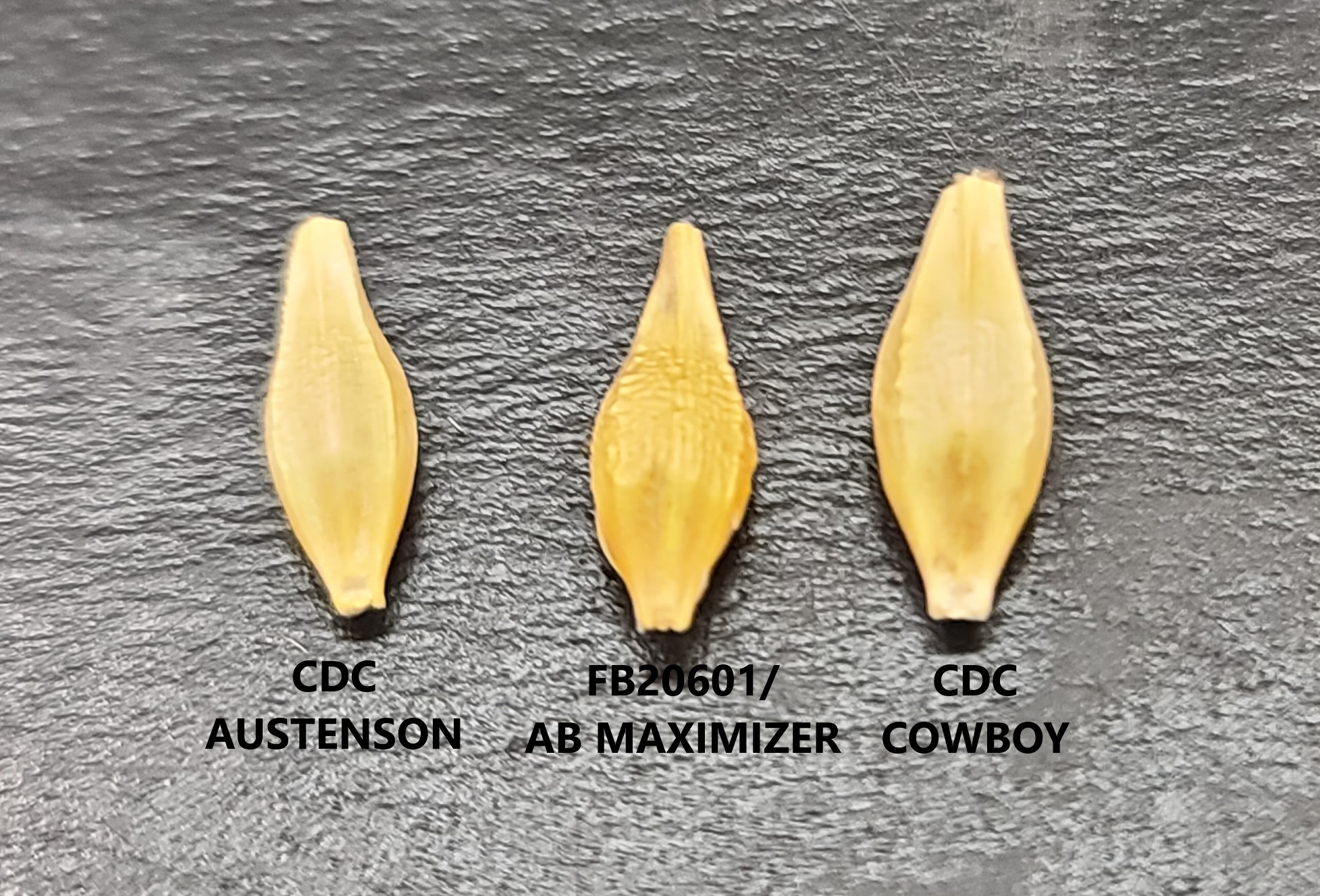AB Maximizer
| Denomination: | 'AB Maximizer' |
|---|---|
| Botanical Name: | Hordeum vulgare |
| Applicant/Holder: |
Alberta Agriculture and Irrigation Crop Assurance and Rural Programming Branch 1st Floor, 7000-113 Street Edmonton, Alberta T6H 5T6 Canada |
| Breeder: |
Yadeta Kabeta, Alberta Agriculture and Forestry, Lacombe, Alberta |
| Agent in Canada: |
Western Crop Innovations 5030-50th Street Lacombe, Alberta T4L 1W8 Canada Tel: 403-391-8617 |
| Application Date: | 2022-11-14 |
| Provisional Protection:: | 2022-11-14 |
| Application Number: | 22-11134 |
| Grant of Rights Date: | 2024-11-12 |
| Certificate Number: | 7226 |
| Grant of Rights Termination Date: | 2044-11-12 |
Variety Description
Varieties used for comparison: 'CDC Austenson' and 'CDC Cowboy'
Summary: At the 5-9 tiller stage, the lower leaf sheath of 'AB Maximizer' has sparse pubescence while that of 'CDC Cowboy' has absent or very sparse pubescence. At booting, the flag leaf auricles of 'AB Maximizer' have a medium intensity of anthocyanin colouration while those of 'CDC Cowboy' have a very strong intensity of anthocyanin colouration. The flag leaf of 'AB Maximizer' is shorter than that of 'CDC Cowboy'. At the end of anthesis, the spike of 'AB Maximizer' has a semi-erect to horizontal attitude while that of 'CDC Austenson' has a erect to semi-erect attitude. At the beginning of ripening, the plants of 'AB Maximizer' are shorter than the plants of 'CDC Cowboy'. The spike of 'AB Maximizer' is shorter than that of 'CDC Cowboy'. At maturity, the rachilla hairs on the kernel of 'AB Maximizer' are long while those of the reference varieties are short. The spiculation of the inner lateral nerves on the kernel of 'AB Maximizer' is strong while it is medium for 'CDC Austenson' and weak for 'CDC Cowboy'. Hairs are present on the ventral furrow of the kernel of 'AB Maximizer' while the ventral furrow on the kernel of 'CDC Austenson' is hairless.
Description:
YOUNG PLANT: semi-erect growth habit at tillering, sparse pubescence on lower leaf sheaths
PLANT: two row, spring feed barley, low frequency of plants with recurved flag leaves
FLAG LEAF (AT BOOTING): sparse pubescence on blade
FLAG LEAF SHEATH: medium glaucosity, sparse pubescence
AURICLES: medium intensity of anthocyanin colouration at booting, sparse pubescence on margins
SPIKE: mid-season emergence, medium glaucosity at end of anthesis, semi-erect to horizontal attitude, platform shaped collar, tapering shape, medium density, divergent sterile spikelet, glume and its awn of the median spikelet are shorter than the grain
LEMMA AWNS: weak intensity of anthocyanin colouration of tips at beginning of anthesis, longer than spike length, rough spiculations on margins
FIRST SEGMENT OF RACHIS: medium length, weak curvature
KERNEL: weak intensity of anthocyanin colouration of nerves of the lemma at early to soft dough stage, long rachilla hairs, husk present, strong spiculation of inner lateral nerves of dorsal side of lemma, hairs present on ventral furrow, clasping disposition of lodicules, incomplete horseshoe shaped basal markings, medium length and width
Origin & Breeding History: 'AB Maximizer' (experimental designations FB20601 and J12037056) was developed using a modified bulk breeding method with marker assisted selection. The variety originated from a cross between the varieties 'Canmore' and 'Merit 57' conducted in 2012 at the Field Crop and Development Centre in Lacombe, Alberta. The variety was advanced from the F1 to F5 generation in Alberta and one season in a winter nursery in California, USA. One F5 line was designated as J12037056 in 2015 based on grain yield, test weight, kernel weight, lodging resistance, straw strength, maturity, disease resistance as well as quality traits. The variety was evaluated from 2016 to 2021 for yield and disease resistance and was further evaluated as FB20601 from 2020 to 2022. Breeder seed was established at the F11 generation in 2021.
Tests & Trials: The comparative trials for 'AB Maximizer' were conducted at the Olds College Field Crop and Development Centre in Lacombe, Alberta in the 2022 and 2023 growing seasons. There were 3 replicates per variety per year. Plots consisted of 8 rows, each row measuring 2.5 metres long with 0.14 metres inter-row spacing. The seeding density of 269 seeds per square metre resulted in approximately 2175 plants per variety per year. Measured characteristics were based on a minimum of 30 measurements per variety per year. Mean differences were significant at the 5% probability level based on a paired Student`s t-test.
Comparison tables for 'AB Maximizer' with reference varieties 'CDC Austenson' and 'CDC Cowboy'
Flag leaf length (at booting) (mm)
| 'AB Maximizer' | 'CDC Austenson' | 'CDC Cowboy' | |
|---|---|---|---|
| mean (2022) | 16.8 | 20.9 | 21.0 |
| std. deviation (2022) | 2.88 | 3.15 | 3.32 |
| mean (2023) | 8.1 | 9.2 | 9.5 |
| std. deviation (2023) | 1.90 | 2.36 | 2.43 |
Plant height (stem plus spike, including awns) (cm)
| 'AB Maximizer' | 'CDC Austenson' | 'CDC Cowboy' | |
|---|---|---|---|
| mean (2022) | 113.0 | 107.0 | 130.0 |
| std. deviation (2022) | 6.65 | 6.49 | 8.62 |
| mean (2023) | 84.0 | 87.0 | 104.0 |
| std. deviation (2023) | 4.90 | 3.06 | 4.05 |
Spike length (excluding awns) (cm)
| 'AB Maximizer' | 'CDC Austenson' | 'CDC Cowboy' | |
|---|---|---|---|
| mean (2022) | 8.0 | 8.0 | 8.6 |
| std. deviation (2022) | 0.69 | 0.54 | 0.80 |
| mean (2023) | 8.1 | 7.3 | 9.0 |
| std. deviation (2023) | 1.14 | 0.58 | 1.01 |
Click on image for larger view

Barley: 'AB Maximizer' (centre) with reference varieties 'CDC Austenson' (left) and 'CDC Cowboy' (right)
Click on image for larger view

Barley: 'AB Maximizer' (centre) with reference varieties 'CDC Cowboy' (left) and 'CDC Austenson' (right)
Click on image for larger view

Barley: 'AB Maximizer' (centre) with reference varieties 'CDC Austenson' (left) and 'CDC Cowboy' (right)
- Date modified: